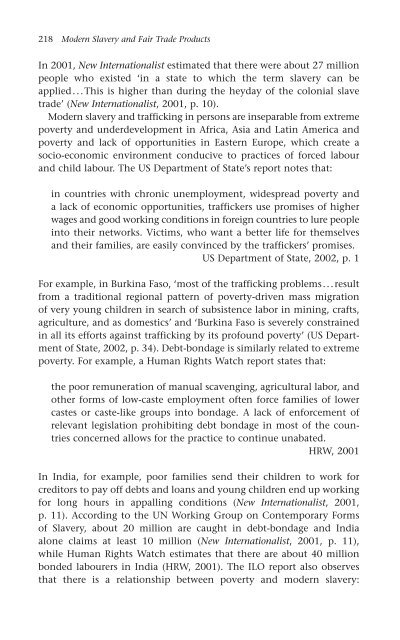3071-The political economy of new slavery
3071-The political economy of new slavery
3071-The political economy of new slavery
You also want an ePaper? Increase the reach of your titles
YUMPU automatically turns print PDFs into web optimized ePapers that Google loves.
218 Modern Slavery and Fair Trade Products<br />
In 2001, New Internationalist estimated that there were about 27 million<br />
people who existed ‘in a state to which the term <strong>slavery</strong> can be<br />
applied...This is higher than during the heyday <strong>of</strong> the colonial slave<br />
trade’ (New Internationalist, 2001, p. 10).<br />
Modern <strong>slavery</strong> and trafficking in persons are inseparable from extreme<br />
poverty and underdevelopment in Africa, Asia and Latin America and<br />
poverty and lack <strong>of</strong> opportunities in Eastern Europe, which create a<br />
socio-economic environment conducive to practices <strong>of</strong> forced labour<br />
and child labour. <strong>The</strong> US Department <strong>of</strong> State’s report notes that:<br />
in countries with chronic unemployment, widespread poverty and<br />
a lack <strong>of</strong> economic opportunities, traffickers use promises <strong>of</strong> higher<br />
wages and good working conditions in foreign countries to lure people<br />
into their networks. Victims, who want a better life for themselves<br />
and their families, are easily convinced by the traffickers’ promises.<br />
US Department <strong>of</strong> State, 2002, p. 1<br />
For example, in Burkina Faso, ‘most <strong>of</strong> the trafficking problems...result<br />
from a traditional regional pattern <strong>of</strong> poverty-driven mass migration<br />
<strong>of</strong> very young children in search <strong>of</strong> subsistence labor in mining, crafts,<br />
agriculture, and as domestics’ and ‘Burkina Faso is severely constrained<br />
in all its efforts against trafficking by its pr<strong>of</strong>ound poverty’ (US Department<br />
<strong>of</strong> State, 2002, p. 34). Debt-bondage is similarly related to extreme<br />
poverty. For example, a Human Rights Watch report states that:<br />
the poor remuneration <strong>of</strong> manual scavenging, agricultural labor, and<br />
other forms <strong>of</strong> low-caste employment <strong>of</strong>ten force families <strong>of</strong> lower<br />
castes or caste-like groups into bondage. A lack <strong>of</strong> enforcement <strong>of</strong><br />
relevant legislation prohibiting debt bondage in most <strong>of</strong> the countries<br />
concerned allows for the practice to continue unabated.<br />
HRW, 2001<br />
In India, for example, poor families send their children to work for<br />
creditors to pay <strong>of</strong>f debts and loans and young children end up working<br />
for long hours in appalling conditions (New Internationalist, 2001,<br />
p. 11). According to the UN Working Group on Contemporary Forms<br />
<strong>of</strong> Slavery, about 20 million are caught in debt-bondage and India<br />
alone claims at least 10 million (New Internationalist, 2001, p. 11),<br />
while Human Rights Watch estimates that there are about 40 million<br />
bonded labourers in India (HRW, 2001). <strong>The</strong> ILO report also observes<br />
that there is a relationship between poverty and modern <strong>slavery</strong>:


